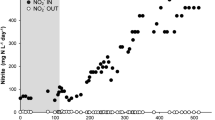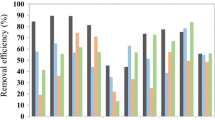Abstract
Changes in the acetoclastic methanogenic activity in the effluentfrom an upflow anaerobic filter (UFAF) were studied throughout a 36 week operating period. The UFAF formed the second phase of a two-phase laboratory-scale anaerobic treatment system. TheSpecific Methanogenic Activity (SMA) test was used to measurethe acetoclastic methanogenic activity of the biomass washed outfrom the UFAF. Throughout the operating period, the SMA testswere carried out at different organic loading rates (OLR) up to6.7 kg COD m-3 d-1 and upflow velocities (UV), 5 m d-1 and 15 m d-1. The results showed that thebiomass washed out from the UFAF consisted of up to 55%(considered as a draft value) acetoclastic methanogens producing550 mI CH4 g-1 VSS d-1. This high acetoclasticmethanogenic activity measured in the effluent might have beendue to the existence of Methanosaeta (formerly Methanothrix) species. Towards the end of operation,Epifluorescence Microscopic examinations in the effluent revealedthat Methanococcus species were the most dominant groupfollowed by medium rods and short rods, filaments and long rodsand the least dominant Methanosarcina species. Theperformance of the UFAF was not adversely affected by the loss ofthe active biomass and changes in their composition. The UFAFsystem achieved over 85% COD removal efficiency at thehighest OLR of 6.7 kg COD m-3 d-1 and UV of 15 m d-1. Throughout most of the operation, methane yield rangedfrom 0.28–035 m3 CH4 kg-1 CODremoved.
Similar content being viewed by others
References
Anderson, G. K., Kasapgil, B. and Ince, O.: 1994, ‘Microbiological study of a two-stage digestion during start-up’, Water Research 28, 2383-2392.
Bryant, M. P.: 1972, ‘Commentary on hungate technique for culture of anaerobic bacteria’, Amer. J. Clin. Nutritious 25, 1324-1327.
Greenberg, A. E., Trussell, R. R. and Clisceri, L. S.: 1985, Standard Methods for Examination of Water and Wastewater, 16th ed., Public Health Association, Washington,D.C.
Hungate, R. E.: 1969, A Roll Tube Method for Cultivation of Strict Anaerobes, Methods in Microbiology, Academic Press, London, 117 pp.
Ince, O., Kasapgil, B. and Yenigun, O.: 2001, ‘Determination of potential methane production capacity of granular sludge from a pilot-scale I. Upflow anaerobic sludge blanket reactor using a specific methanogenic activity tests’, J. Chem. Technol Biotechnol. 76, 573-578.
Ince, O., Anderson, G. K. and Kasapgil, B.: 1997, ‘Composition of the microbial population in a membrane anaerobic system during start-up’, Water Research 31, 1-10.
Ince, O., Anderson, G. K. and Kasapgil, B.: 1995a, ‘Control of organic loading rate using the specific methanogenic activity test during start-up of an anaerobic digestion system’, Water Research 29, 345-355.
Ince, O., Anderson, G. K. and Kasapgil, B.: 1995b, ‘Effect of changes in composition of methanogenic species on performance of a membrane anaerobic reactor system treating brewery wastewater’, Environ. Technol. 16, 901-914.
Ince, O., Anderson, G. K. and Kasapgil, B.: 1994, ‘Use of the Specific Methanogenic Activity Test for Controlling the Stability and Performance in Anaerobic Digestion of Brewery Wastewater’, Proceedings of 49th Purdue Industrial Waste Conference, Lafayette, U.S.A., May 1994, pp. 189-204.
McCarty, P. L.: 1964, ‘Anaerobic waste treatment fundamentals’, Public Works 95, 107-112.
Monteggia, L.: 1991, ‘The Use of a Specific Methanogenic Activity for Controlling Anaerobic Reactors’, Ph.D. Thesis, The University of Newcastle upon Tyne, U.K.
Morgan, J.W., Evison, L. M. and Forster, C. F.: 1991, ‘Changes to the microbiol ecology in anaerobic digesters treating ice cream wastewater during start-up’, Water Research 25, 639-653.
Pike, E. B., Carrington, E. G. and Ashburner, P. A.: 1972,‘ An evaluation of procedures for enumeration of bacteria in activated sludge’, J. Appl. Bacteriol. 35, 309-321.
Reynolds, P. J.: 1986, ‘Support Matrix and Feed-Flow Effects in Anaerobic Fixed-Bed Reactor’, Ph.D. Thesis, National University of Ireland.
Siebert, M. L. and Hattingh, W. H. J.: 1987, ‘Estimation of methane-producing bacterial numbers by the most probable (MPN) technique’, Water Research 27, 13-19.
Valcke, D. and Verstraete, W.: 1983, ‘A practical method to estimate the acetoclastic methanogenic biomass in anaerobic reactors’, J. Water Pollut. Contr. Federation 55, 1191-1195.
Zehnder, A. J. B., Huser, B. A., Brock, T. D. and Wuhrmann, K.: 1980, ‘Characterisation of acetatedecarboxylating, non-hydrogen-oxidising methane bacteria’, Archiv. Microbiol. 124, 1-11.
Author information
Authors and Affiliations
Corresponding author
Rights and permissions
About this article
Cite this article
Ince, B.K., Ince, O. & Ayman Oz, N. Changes in Acetoclastic Methanogenic Activity and Microbial Composition in an Upflow Anaerobic Filter. Water, Air, & Soil Pollution 144, 301–315 (2003). https://doi.org/10.1023/A:1022917217474
Issue Date:
DOI: https://doi.org/10.1023/A:1022917217474




